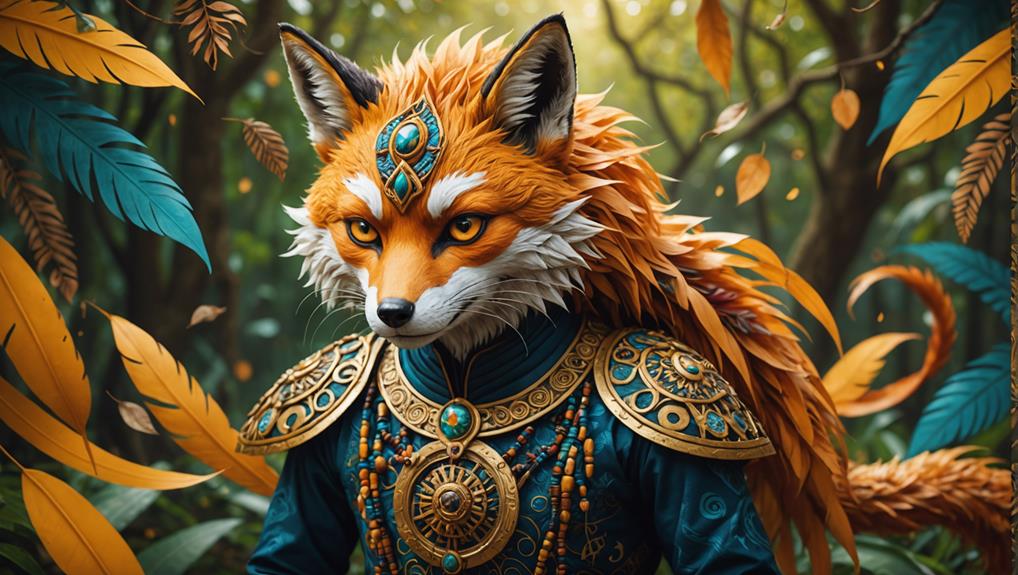As you explore the symbolism of foxes in folklore, you'll discover a fascinating array of contradictory qualities, from cunning tricksters to benevolent guides, and from symbols of fertility to harbingers of change. In Japanese mythology, kitsune embody mystical powers and shape-shifting abilities. In Native American lore, foxes serve as spiritual guides and messengers between realms. European tales feature the cunning fox, outsmarting humans and gods alike. Foxes also symbolize transformation, omens, and fertility, weaving a rich tapestry of meanings that reveal the complexities of human nature and our place in the world – and that's just the beginning of the story.
Contents
- 1 Foxes in Japanese Mythology: The Kitsune
- 2 Native American Lore: Fox as a Guide
- 3 European Tales: The Cunning Fox
- 4 Shape-Shifting and Transformation
- 5 Foxes as Harbingers and Omens
- 6 Agricultural Deities and Foxes
- 7 Fox Symbolism in Norse Mythology
- 8 Foxes in Celtic Mythology: Spirit Guides
- 9 Foxes in African Folklore: Trickster Gods
- 10 Foxes in Mesopotamian Mythology: Sacred Animals
- 11 Final Thoughts
Foxes in Japanese Mythology: The Kitsune
In Japanese mythology, you'll encounter the enigmatic kitsune, a fox spirit revered for its mystical powers and versatility. As a divine messenger of Inari, the Shinto deity of rice, kitsune are believed to possess powerful spiritual and protective qualities.
The number of tails a kitsune has signifies its age, power, and wisdom, with a nine-tailed fox being the most powerful and revered manifestation. While often depicted as benevolent protectors and bringers of good fortune, kitsune can also embody trickster traits, causing mischief and leading humans astray in various folktales.
This duality reflects the complexity of human nature and moral lessons within the narratives. As you delve deeper into Japanese mythology, you'll discover that kitsune aren't just mystical beings but also symbolize the balance between good and evil.
Native American Lore: Fox as a Guide
Beyond the realms of Japanese mythology, the fox assumes a new role as a trusted guide in Native American lore. As you delve into the world of Native American traditions, you'll discover that the fox is revered as a spiritual guide, often serving as a messenger between the physical and spiritual realms.
Foxes embody qualities of cunning and intelligence, which are viewed as valuable traits for navigating life's challenges and complexities. Some tribes believe that foxes possess magical abilities, offering protection and guidance during difficult times, reflecting a deep connection to the natural world.
In stories, the fox may be depicted as a trickster figure, teaching important life lessons about humility, adaptability, and the consequences of deceit. Additionally, the fox is sometimes associated with healing and transformation, symbolizing the ability to overcome obstacles and emerge stronger from adversity.
As a guide, the fox helps you tap into your own resilience and resourcefulness, encouraging you to stay adaptable and humble in the face of life's twists and turns.
European Tales: The Cunning Fox

Delve into the realm of European folklore, where the fox assumes a new persona as a cunning trickster. You'll find that the symbolism of foxes is deeply rooted in their cunning nature, often depicting them as clever and resourceful.
Take, for instance, the character of Reynard the Fox, who embodies scheming intelligence and mischief within medieval fables.
In Aesop's famous tale, "The Fox and the Grapes," the fox's cunning nature is exemplified as it dismisses the unattainable grapes as sour, illustrating the concept of cognitive dissonance.
Similarly, in Bulgarian and Russian folklore, Kuma Lisa, the female fox trickster, uses her cleverness to outsmart humans and other animals, offering a feminine twist on the traditional fox archetype.
In Finnish folklore, foxes are associated with cunning and intelligence, often depicted as adept in eluding hunters and outsmarting both humans and their enemies in the wild.
Moreover, in Greek myths, the fox's cunning nature is symbolically linked to the vitality of the vine and fertility, where it guards the vineyards and is integral to the deity Dionysus's narrative, emphasizing its clever and protective traits.
Shape-Shifting and Transformation
You venture into the realm of shape-shifting and transformation, where foxes in folklore take on a multitude of forms, blurring the lines between reality and illusion.
In Japanese folklore, you'll find kitsune, shape-shifting foxes that transform into beautiful women, symbolizing duality and deception.
Meanwhile, in many Native American myths, foxes navigate between realms, showcasing their intelligence and cunning in adapting to various situations.
The Celtic tradition views foxes as spirit guides capable of transformation, bridging the physical and spiritual realms.
In Chinese mythology, fox spirits (huli jing) take on human form, often exhibiting mischievous behavior, reflecting the cultural perception of their unpredictable nature.
Through these diverse tales, fox symbolism highlights the fluidity of identity and the potential for change in complex moral situations.
As you delve deeper, you'll discover that shape-shifting foxes represent the power of transformation, encouraging you to embrace change and adapt to life's twists and turns.
Foxes as Harbingers and Omens

As you explore the realm of fox symbolism, you'll find that these cunning creatures also serve as harbingers and omens, carrying messages from the spiritual realm to the physical world.
In many Indigenous cultures, foxes signal changes in the environment or the arrival of important events in the community. They're like messengers, alerting you to shifts in the natural world or your personal life.
In Japanese folklore, the kitsune, or fox spirit, is often seen as an omen of fortune or misfortune, with its presence indicating significant shifts in a person's life or spiritual journey.
Similarly, in Celtic traditions, the appearance of a fox is interpreted as an omen of guidance, nudging individuals toward embracing their cunning or resourcefulness in facing challenges.
In African folklore, foxes bring warnings or foretell mischief, emphasizing their role as messengers of change and unpredictability.
Meanwhile, in some Native American traditions, seeing a fox can serve as a harbinger of new beginnings or visual cues to trust one's instincts, thereby highlighting their connection to spiritual insight and guidance.
Fox symbolism teaches you to stay attuned to the world around you, listening to the whispers of the natural world, and trusting your inner wisdom.
Agricultural Deities and Foxes
While exploring the multifaceted realm of fox symbolism, it becomes apparent that these cunning creatures have a profound connection to agricultural deities across various cultures.
In many societies, foxes are revered as symbols of intelligence, cleverness, and adaptability – essential qualities for thriving in the ever-changing world of agriculture.
Here are three examples of agricultural deities associated with foxes:
- Isis and Bastet in ancient Egyptian mythology: Foxes were linked to these goddesses, representing fertility and motherhood, crucial aspects of agriculture.
- Inari, the Japanese rice deity: Kitsune (fox spirits) are believed to be messengers of Inari, highlighting the intimate connection between foxes and agricultural prosperity.
- Celtic tradition's symbol of renewal: The fox embodies the connection between agricultural cycles and the changing seasons, emphasizing the importance of transformation and renewal.
As you delve deeper into the world of fox symbolism, it's clear that these clever creatures have played a significant role in shaping our understanding of the natural world and our relationship with the land.
Fox Symbolism in Norse Mythology

Freya's cloak, made from the silken fur of a fox, symbolized her adaptability and connection to the natural world, reflecting the cunning and clever nature of the fox in Norse mythology.
You'll often find the fox associated with the goddess Freya, embodying traits like cleverness and adaptability.
In Norse myths, foxes are commonly depicted as masterminds, outsmarting both men and gods alike with their cunning nature. This is evident in tales of manipulation and strategy, solidifying their reputation as tricksters.
The mythological figure of Loki, known for his shape-shifting and trickery, shares similar traits with the fox, emphasizing their unpredictable nature.
What's fascinating is that foxes in Norse mythology symbolize the connection between the human world and the spirit realm, much like their roles in other cultures as guides and protectors.
Symbolism Across Cultures, the fox is often a symbol of cleverness and adaptability, reflecting their importance in Norse mythology.
Foxes in Celtic Mythology: Spirit Guides
In Celtic mythology, you'll find the fox takes on a more mystical role, serving as a spiritual guide that bridges the physical and spiritual realms. This wise and intuitive creature is seen as a symbol of wisdom, guiding you through life's complexities and challenges.
The fox is often associated with the goddess Brigid, representing healing, fertility, and renewal through transformation. This connection emphasizes the fox's role in facilitating personal growth and positive change.
Here are three key aspects of the fox's spiritual guidance in Celtic mythology:
- Messenger and Protector: Foxes are believed to embody cleverness and adaptability, making them effective messengers and protectors in the spiritual realm.
- Navigator of Realms: The fox is seen as a guide that can traverse different worlds, offering valuable insight and wisdom to shamans and seekers during spiritual journeys.
- Symbol of Strategy: As a symbol of strategy and resourcefulness, the fox encourages you to trust your instincts and navigate life's complexities with confidence and adaptability.
Foxes in African Folklore: Trickster Gods

As you delve into the rich tapestry of African folklore, the fox's role transforms, taking on the persona of a cunning trickster god. In Dogon mythology from Mali, the fox is revered for its cunning and cleverness, symbolizing the duality of creation and chaos.
You'll find that Tswana culture from Botswana features riddles that involve foxes, emphasizing the importance of intelligence and cleverness in daily life and success.
The fox in various African tales often serves as a mediator, using its wit to navigate conflicts between humans and other animals while delivering moral lessons. In Akan folklore from Ghana, the fox is a symbol of fate and fortune, highlighting its role in storytelling that imparts wisdom through humor and trickery.
Through these stories, you'll learn about the consequences of deceit and the balance of power, as the trickster narrative engages audiences and teaches ethical lessons. As you explore these tales, you'll discover how the fox's cleverness and wit have become synonymous with African folklore, inspiring you to appreciate the importance of intelligence, morality, and balance in your own life.
Foxes in Mesopotamian Mythology: Sacred Animals
As you explore the ancient Mesopotamian pantheon, you'll discover that foxes held a sacred status, closely tied to the revered goddess Ninhursag, who embodied the nurturing aspects of nature.
This association with Ninhursag granted foxes a symbolic connection to fertility and the cycles of agriculture.
Sacred Fox Associations
Through the lens of Mesopotamian mythology, you'll find foxes elevated to sacred status, closely tied to the goddess Ninhursag, who embodies the fertile and nurturing aspects of the earth.
As sacred animals, foxes are revered for their symbolic connection to the natural world and the cycles of life.
In Mesopotamian stories, foxes often represent wisdom and shrewdness, celebrated for their ability to navigate both the natural and supernatural worlds.
This duality is reflected in their portrayal in art, where they're frequently depicted in religious and cultural rituals, particularly those involving agriculture and harvest.
Here are three key aspects of sacred fox associations:
- Fertility and Nurturing: Foxes are linked to the goddess Ninhursag, who embodies the fertile and nurturing aspects of the earth, highlighting their connection to the natural world.
- Wisdom and Shrewdness: Foxes symbolize wisdom and shrewdness, celebrated for their ability to navigate both the natural and supernatural worlds.
- Agriculture and Harvest: Foxes are frequently portrayed in Mesopotamian art, particularly in rituals involving agriculture and harvest, underscoring their importance in religious and cultural practices.
Fox Goddess Ninhursag
In the heart of Mesopotamian mythology, the fox goddess Ninhursag reigns supreme, embodying the life-giving forces of nature and nurturing the land with her maternal instincts. As you delve into the stories surrounding this powerful deity, you'll discover that foxes play a significant role in her cult, symbolizing protection and guidance.
In this context, the fox represents cleverness and adaptability, traits that resonate with Ninhursag's role in creation and sustenance of life. You'll find that foxes are seen as mediators between the physical and spiritual worlds, which is why they're so prominent in rituals and sacred spaces dedicated to the goddess.
Mesopotamian art and literature further solidify the connection between foxes and divine attributes, highlighting their importance in agricultural and nurturing practices. As you explore the mythology surrounding Ninhursag, you'll come to appreciate the fox as a symbol of fertility, nurturing, and life-giving forces.
The fox goddess Ninhursag and her sacred animal companions will leave you in awe of the rich cultural heritage of Mesopotamian mythology.
Final Thoughts
As you've explored the fascinating world of fox symbolism, you've likely noticed a common thread – the fox's adaptability and cunning. Like the fox that outsmarts the hunter, these cultural symbolisms have evolved to reflect the complexities of human nature. Imagine a fox weaving through a forest, leaving behind a trail of wisdom, guidance, and transformation. That's what these symbolisms offer – a rich tapestry of insights to navigate life's twists and turns.














